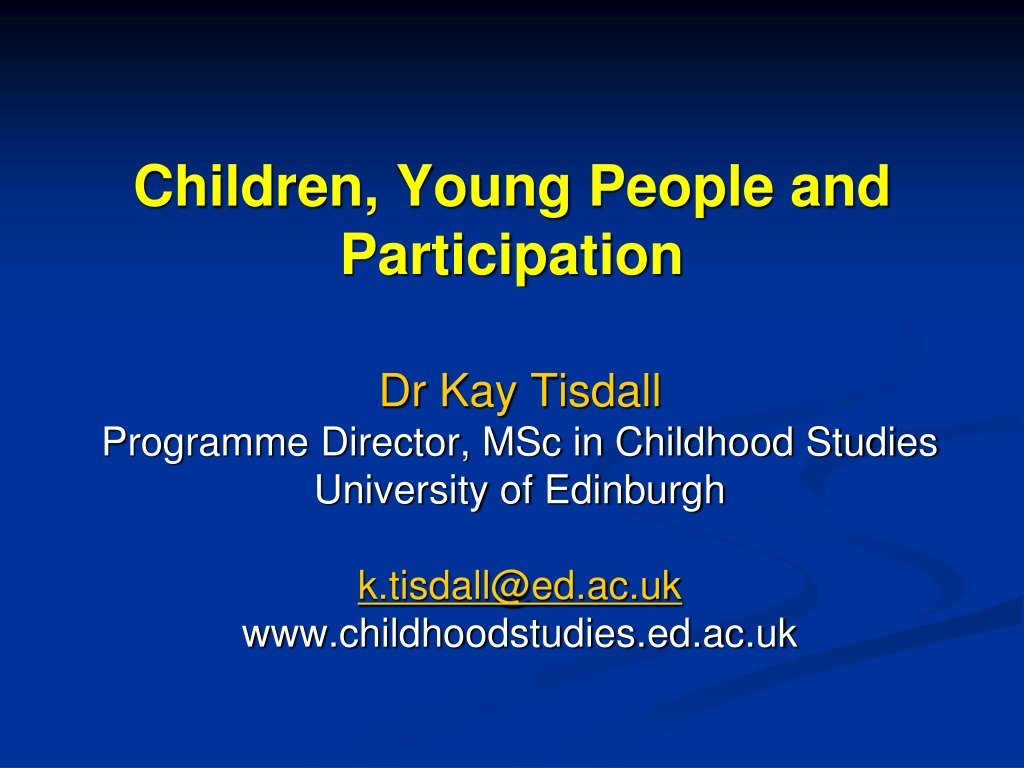Exploring Children's Participation and Rights in Decision-Making
The participation of children and young people in decision-making processes is crucial, with an emphasis on providing opportunities for them to express their views, make choices, and influence programs. This concept has gained prominence in policy and legislation, aided by the UNCRC. However, challenges such as interpreting children's views, ensuring meaningful participation, and ethical considerations persist. Discourses highlight the importance of upholding children's rights, enhancing skills, and promoting protection. Areas such as performance, political mobilization, and age discrimination require further attention.
Download Presentation

Please find below an Image/Link to download the presentation.
The content on the website is provided AS IS for your information and personal use only. It may not be sold, licensed, or shared on other websites without obtaining consent from the author. Download presentation by click this link. If you encounter any issues during the download, it is possible that the publisher has removed the file from their server.
E N D
Presentation Transcript
Children, Young People and Participation Dr Kay Tisdall Programme Director, MSc in Childhood Studies University of Edinburgh k.tisdall@ed.ac.uk www.childhoodstudies.ed.ac.uk
You are the manager of a day nursery. The Care Commission is coming to inspect. Your staff ask you what does this standard mean? Children and young people will have opportunities to express their views, exercise choice and, where possible, influence the programme. (Standard 5.4)
The good news story The participation of children and young people in public decision-making has gained unprecedented policy prominence. Children s rights to participate are increasingly recognised in the UK, in official government policy and legislation. This has been greatly assisted by the UNCRC. Services are increasingly expected to involve children and young people. Participation activities have proliferated.
Is it clear what the purpose of the participation is? Is it purposeful or just a tick box ? Which children are included? How do we (adults) interpret what children are saying? How do children s views fit amongst other stakeholders? Is the participation meaningful to those involved? Is the participation having any impact on decisions? Is the participation ethical? (Sinclair 2004) What challenges do you face? 1. 2. 3. 4. 5. 6. 7.
Discourses of Participation To uphold children s rights To fulfil legal responsibilities To improve services To improve decision-making To enhance democratic processes To promote children s protection To enhance children s skills To empower and enhance self-esteem 1. 2. 3. 4. 5. 6. 7. 8. Sinclair and Franklin 2000
What is not there? Performance Political mobilisation and emancipation Age discrimination
Back to the vignette You are the manager of a day nursery. The Care Commission is coming to inspect. Your staff ask you what does this standard mean? Children and young people will have opportunities to express their views, exercise choice and, where possible, influence the programme. (Standard 5.4) The involvement of young children A fixation on voice ? The role of adults
References Sinclair, R. and Franklin, A., Young People s Participation Quality Protects Research Briefing (2000) accessed at http://www.rip.org.uk/publications/documents/QPB/QPB3.PDF (2.11.07) Sinclair, R. (2004) Participation in practice: making it meaningful, effective and sustainable , Children & Society, 18(2): 106-118. Related papers Tisdall, E.K.M. (2009) Governance, Civil Society and Participation , in Percy-Smith, B. and Thomas, N. (eds) A Handbook of Children s Participation, London: Routledge. (forthcoming) Tisdall, E.K.M. (2008) The rise of a new profession? Children s participation workers , in Allan, J., Ozga, J. and Smyth, G. (Eds) Social Capital, Professionalism and Diversity, Rotterdam: Sense Publishers. (forthcoming) Tisdall, E.K.M. (2008) Is the honeymoon over? Children and Young People s Participation in Public Decision-Making International Journal of Children s Rights, Special Issue 16(3): 419-429. Tisdall, E.K.M., Davis, J.M. and Gallagher, M. (2008) Reflecting upon children and young people s participation in the UK , International Journal of Children s Rights, Special Issue 16(3): 343-354. Tisdall, E.K.M. and Bell, R. (2006) Included in Governance? Children s participation in public decision-making in Tisdall, E.K.M., Davis, J., Hill, M. and Prout, A. (Eds) Children, young people and social inclusion: participation for what? Bristol: Policy Press, pp. 105-120. Tisdall, K. and Davis, J. (2004) Making a Difference? Bringing children s and young people s views into policy-making Children & Society 18(2): 131-142. Hill, M., Davis, J., Prout, A. and Tisdall, K. (2004) Moving the participation agenda forward Children & Society 18(2): 77-96.























